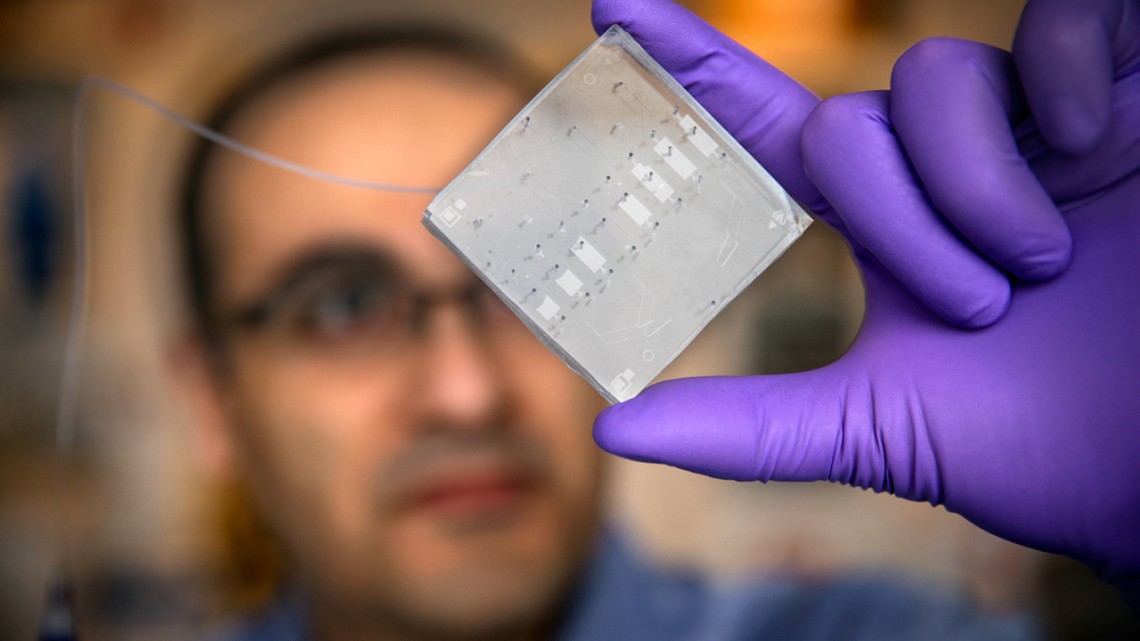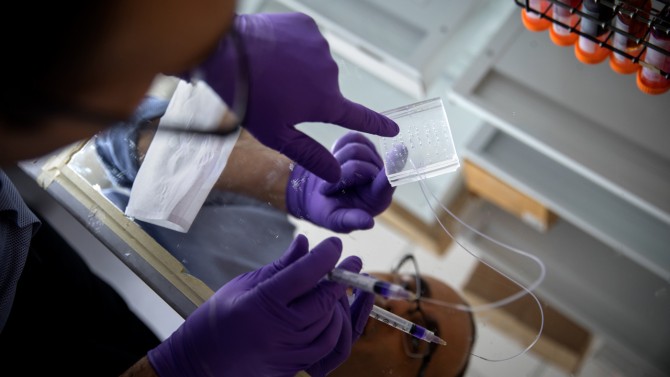
Alireza Abbaspourrad, the Yongkeun Joh Assistant Professor of Food Chemistry and Ingredient Technology in the Department of Food Science, holds a "gut-on-a-chip."
Food scientist works to improve nutrition, understand gut disease
By Krisy Gashler
The difficulties of conducting research on the human gut are substantial: the presence of trillions of bacterial cells interacting with human cells and each other, constant environmental changes every time food is consumed and zero chance of conducting trials that control for all those moving parts.
However, gaining a better understanding of how food moves through the body is especially important for helping those with poorly understood gastrointestinal disorders, like Crohn’s disease.
One groundbreaking solution, called a “gut-on-a-chip,” involves creating a three-dimensional, microscale model of the human intestinal tract. Composed of biocompatible hydrogels with tunable physicochemical properties, the model recreates the intestinal matrix with villi structures that mimic the mucous-membrane layer of the small intestine. These structures are critical for nutrient absorption.
Alireza Abbaspourrad, the Yongkeun Joh Assistant Professor of Food Chemistry and Ingredient Technology in the Department of Food Science, has been working for the past year and a half to develop novel approaches to improving the current models. He is one of just a handful of other pathbreaking researchers who are developing similar devices, including John March, professor and chair in the Department of Biological and Environmental Engineering.
“Our hope in the lab is to create healthier, more nutritious foods, and also to help treatment of diseases through understanding ingredients’ effects on intestinal cells and microbiome populations in our gut-on-a-chip model,” Abbaspourrad said.
The device allows researchers to control for variables like nutrients and gut bacteria with tremendous specificity while using human cell lines, a feat that is impossible with current studies that use lab animals or human trials.
With his model, Abbaspourrad is studying the interactions between multiple strains of bacteria in the gut, assessing toxicity of ingredients and understanding how much of certain nutrients is actually available for our bodies to use, a concept known as bioavailability.
“All of us are becoming more aware and more questioning about how much of a certain ingredient is available for our body to uptake, rather than just how much of it exists in a food,” Abbaspourrad said. “This is the next step in better understanding how certain foods may positively affect our health.”
Abbaspourrad is also using microencapsulation technology to protect and deliver bioactive ingredients to the right parts of the body. For example, people who consume probiotics are trying to to get more beneficial bacteria in the large intestine; however, most of the probiotics are destroyed before they can get there.
“We need to bypass the acidic condition of the stomach, deliver those probiotics to the intestine to see their beneficial effects,” he said. “People have tried to work on this; however, this is very challenging and we are trying to address this question using microencapsulation technology.”
Krisy Gashler is a freelance writer for the College of Agriculture and Life Sciences.
Media Contact
Get Cornell news delivered right to your inbox.
Subscribe

